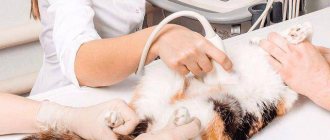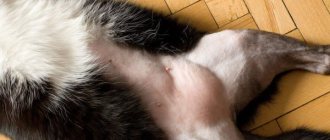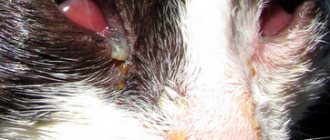Owners of domestic cats sometimes notice the appearance of discharge from the vaginal area, which is a liquid substance. The nature of the discharge may be serous or watery, and may also contain blood or pus (yellowish or green discharge). After the end of the birth process, vaginal discharge is dark, sometimes black or greenish.
The appearance of discharge from the vaginal area does not always indicate the development of a pathological process in the female reproductive system. Some types of discharge are physiologically determined and do not pose a threat to the life of the animal.
The presence of discharge in an animal should not be ignored, since in some cases such a symptom indicates the development of pathological changes in the area of not only the genital tract, but also the urinary system. It is recommended to contact a veterinary clinic to determine the nature of the origin of the cat’s discharge. The doctor will be able to make an accurate diagnosis and prescribe appropriate treatment.
Discharge in a cat, which is a physiological norm
During heat, a cat secretes a clear fluid that goes unnoticed because the cat is constantly licking itself. Twenty days after mating, a pregnant cat secretes a little clear and thick mucus in her urine. This is part of the plug that clogs the cervix, necessary to protect the organ from infection.
In the sixth week of gestation, excess amniotic fluid is released. You need to be sure whether the cat is pregnant. If this is the case, then the release of a small amount of clear liquid is not a cause for concern.
A few hours before birth, white or yellowish discharge appears, sometimes slightly bloody. After the start of contractions, the amniotic fluid leaves, greenish or fawn, transparent.
Possible pathologies accompanied by discharge
Most often, any discharge from the genital organs indicates gynecological pathologies of the genital organs:
- Vaginitis is an inflammation of the vaginal mucosa.
The cat's discharge is yellow, yellow-white or mucopurulent. Almost always cloudy.
- Endometritis is an inflammation affecting the mucous and muscular walls of the uterus. In itself, it is not dangerous and can be successfully treated, but sometimes it can develop into a more dangerous pathology such as pyometra.
The cat experiences yellow-green or mucopurulent discharge, most often after 2-7 days from the birth of the kittens. Usually without a pronounced pungent odor
- Hydrometra - often develops against the background of endometritis, when fluid, mucus and exudate accumulate in the uterine cavity (up to 10 l).
When the form is open, the cat may have discharge that is yellow, whitish, and watery.
- Pyometra is a purulent inflammation of the uterus with accumulation of pus in its cavity.
There is no pure yellow discharge, there are gray-green, yellow-green, green and almost always with a foul odor.
- Hematometra is inflammation of the uterus with accumulation of bloody contents.
The discharge is usually red, red-green.
What kind of discharge in cats is considered unhealthy?
Suspicions of a pathological process are caused by vaginal discharge of the following type and consistency:
- White, if they are not associated with pregnancy or childbirth, then indicate vaginitis or pyometra. An additional pathological symptom is an unpleasant odor.
- Yellow-colored or bloody, foul-smelling, occur with postpartum endometritis or miscarriage.
Be sure to read:
Seizures in a cat: physiological and pathological causes, symptoms, first aid, treatment
Purulent discharge
The inflammatory process begins with the release of liquid transparent mucus, which gradually thickens, becomes opaque, first white, then acquires a creamy, yellowish, greenish or brown color. Darkening of the exudate is a sign indicating the death of mucosal tissue.
Your cat is bleeding: what to do?
When blood flows from the vagina in drops, clots, or along with exudate, it means that the cat has developed hematometra - a life-threatening illness.
The symptom indicates a violation of the integrity of blood vessels. In this case, urgent veterinary assistance is required.
Dangerous symptoms
If a cat’s blood is released from the vagina in clots due to the progression of dangerous disorders in the body, the following pathological symptoms will be additionally disturbing:
- decreased animal activity;
- loss of appetite or complete refusal of food and water;
- frequent or infrequent painful urination with blood;
- thorough licking of the anterior passage;
- increased body temperature;
- tachycardia, breathing problems.
Acute urethritis in a cat is accompanied by severe polyuria and irrepressible thirst. If the owner notices that blood or purulent fluid is flowing from under the tail, this symptom indicates the development of complications that cannot be dealt with without medical help.
A cat has white uterine discharge: normal or pathological?
White genital discharge, if it is not associated with pregnancy or labor, is pus. Most often they occur due to decreased immunity as a result of the use of hormonal contraceptives or hormonal anti-inflammatory drugs.
Staphylococci are activated, which constantly live in the body and do not cause harm to health with a normally functioning immune system. Vaginitis develops.
Another cause of the disease is the consequences of mating with a cat infected with chlamydia, toxoplasma, feline immunodeficiency virus, and mycoplasma.
After a difficult birth, fragments of the placenta remain in the uterus, they fester, leading to endometritis. The most dangerous pathology that begins with white discharge is pyometra. The discharge becomes colored or stops. If additional symptoms appear - depression, pain in the enlarged abdomen, it means that pyometra has passed into the most dangerous - closed form. The pus does not come out, but accumulates inside the uterus.
In older animals, suppuration may be a symptom of a tumor process. The main reason for the occurrence of neoplasms is repeated hormonal disruptions caused by the termination of an unwanted pregnancy or the use of drugs to disrupt estrus.
First, a false pregnancy develops. The animal gets worried, begins to prepare the nest, and spoils the situation. She produces milk, but no kittens. Repeated imaginary tightness is dangerous because it triggers the process of development of neoplasms.
Be sure to read:
What to do if your cat’s ears are red, itchy or spots appear: causes of the disease
Prevention
If fluid drips from the organs of the genitourinary system for physiological reasons, but the animal is not planned to be mated, it is better to sterilize it to avoid pathological complications associated with hormonal surges. When a cat has a history of inflammatory and other diseases of the urinary system, it is recommended to periodically visit a veterinarian, do a preventive ultrasound, promptly treat internal diseases, do routine vaccinations, and if pathological symptoms develop, do not self-medicate, but find out the diagnosis as soon as possible and begin treatment. therapy under the supervision of a physician.
Treatment of white discharge in cats
If leucorrhoea is accompanied by an unpleasant odor, this is a reason to contact a veterinarian. After a clinical examination and laboratory tests, the doctor assesses the general condition of the cat and prescribes treatment. prescribes treatment.
With timely treatment, it is possible to use conservative therapy methods. Vaginitis or open pyometra is treated with douching. The cat owner should ask a veterinarian or experienced felinologist how this is done.
Medicines based on furatsilin or chlorhexidine are taken into a rubber syringe and carefully squeezed into the vagina. At the same time, oral antibiotics or sulfonamides are prescribed.
The radical method of treatment is castration. Indications: closed pyometra, cancer, age over 6 years. In Russia, castration is called sterilization, although these are different operations.
Residents of high-rise buildings get a cat, but do not know what to do with it when it reaches sexual maturity. The call of nature, not supported by mating, causes torment for the pet and those around her. A reliable way to prevent it is to remove the uterus with ovaries and appendages at 8-10 months.
In this case, the cat will never have white or differently colored discharge from the loop. The disadvantage is the need to use expensive specialized food for sterilized cats to avoid obesity.
Treatment
Therapeutic measures are prescribed if it is determined that vaginal discharge is pathological. Depending on the diagnosis, the following medical techniques are used:
- Hemostatic therapy if a blood clotting disorder is established.
- Inhibition of the activity of pathogenic microflora. Antibiotic therapy.
- Extirpation of the uterus.
- Removal of tumors.
The use of steroidal antiphlogistic drugs is contraindicated. An attempt at self-medication poses a mortal threat to the pet, causing immediate death or provoking the formation of malignant tumors.
We invite you to join our Zen channel and group on VKontakte or Odnoklassniki, where new articles for pet owners are published.
Similar articles:
- My cat has a nosebleed - what should I do?
- Inflammation of the lower lip in a cat
- Clear nasal discharge in cats
Diagnostics
You cannot solve the problem of “brown cat discharge” on your own, so take your pet to a qualified veterinarian. After a couple of questions, your veterinarian will perform a physical test by gently pressing on your pet's glands. Healthy glands should secrete thin yellow fluids, while enlarged glands should secrete thick brown fluids. It is worth noting that you should inform the veterinarian about your pet's condition before admission, such as diarrhea, soft stools,... To rule out other diseases, determine the exact cause and develop an appropriate treatment regimen, the veterinarian will perform chemical testing, including urinalysis, electrolyte analysis, blood test...
© shutterstock
A reason to consult a specialist!
In all of the above dangerous (!) situations, you should not risk the health of your tailed pet and “make a diagnosis” on Internet forums - “guess the tea leaves”, but it is better to consult with a veterinarian by toll-free phone, then make a house call or make an appointment , if required.
Then timely treatment will return the mustachioed and striped beauty to excellent health, and you will be in a good mood! And may it “never leave you again!”
Symptoms of anal sac diseases
Once you understand the nature of anal sac diseases, you can easily monitor the symptoms. Because overcrowded glands cause irritation, cats will lick, run, and perform all sorts of tricks to remove fluid from the inside. In extreme cases, cats may resort to scratching and biting for a purpose that is dangerous.
Since a cat's anal glands are only supposed to secrete fluid during bowel movements, any other type of discharge is a problem. Therefore, if you see traces of brown fluid, your pet has an anal sac disorder.
2. Reasons
The least dangerous cause can be considered abnormally liquid sulfur, as the secretion of the ceruminous glands of the external auditory canal is colloquially called. Due to individual characteristics and/or under the influence of certain irritating factors, the sulfur glands can produce protective “lubricant” in excess quantities and with atypical rheological properties. This situation, however, also requires mandatory consultation with an otolaryngologist.
Relatively rare is cholesteatoma, a complex encapsulated formation of dead cells, connective tissue and cholesterol; this is a pseudotumor, which, in the case of an associated infection, can lead to otorrhea (discharge from cholesteatoma, as a rule, has a specific putrefactive odor).
However, in the vast majority of cases, when examined for otorrhea, the causes are identified as inflammatory processes in various parts of the hearing organs, which are infectious (bacterial, fungal, viral, combined), allergic or mixed infectious-allergic in nature:
- otitis externa;
- acute otitis media;
- chronic purulent otitis media;
- exudative otitis media (accumulation of volumes of non-purulent fluid requiring release);
- mastoiditis (inflammation of the mastoid process of the temporal bone);
- furunculosis of the external auditory canal (a bacterial, usually staphylococcal infection of the hair follicles and/or sebaceous glands in the ear canal, which is often one of the first symptoms of diabetes).
The immediate cause of otorrhea in purulent and exudative “internal” otitis is perforation of the eardrum, which provides an outlet for the accumulated masses.
Relatively less common:
- traumatic otoliquorrhea (leakage of cerebrospinal fluid from the ear canal, usually due to a fracture of the base of the skull);
- otorrhea caused by a progressive tumor process.
Visit our Otolaryngology (ENT) page











